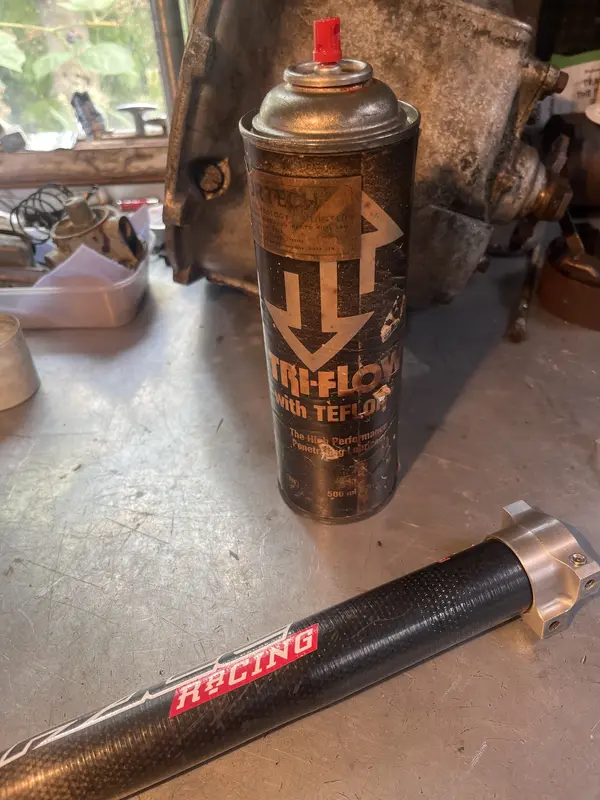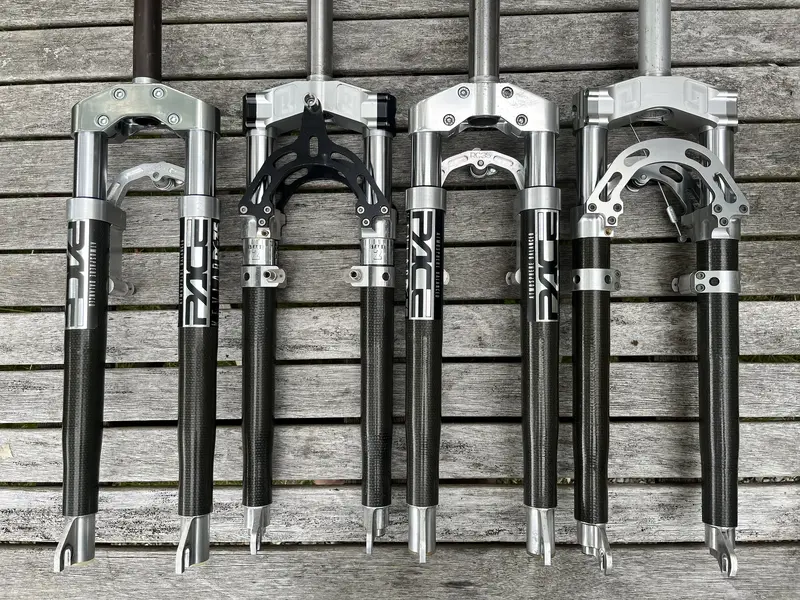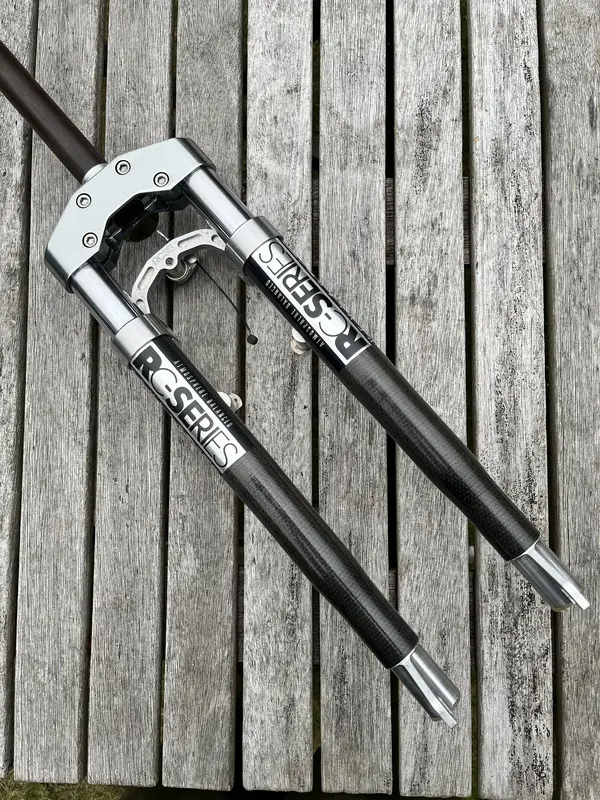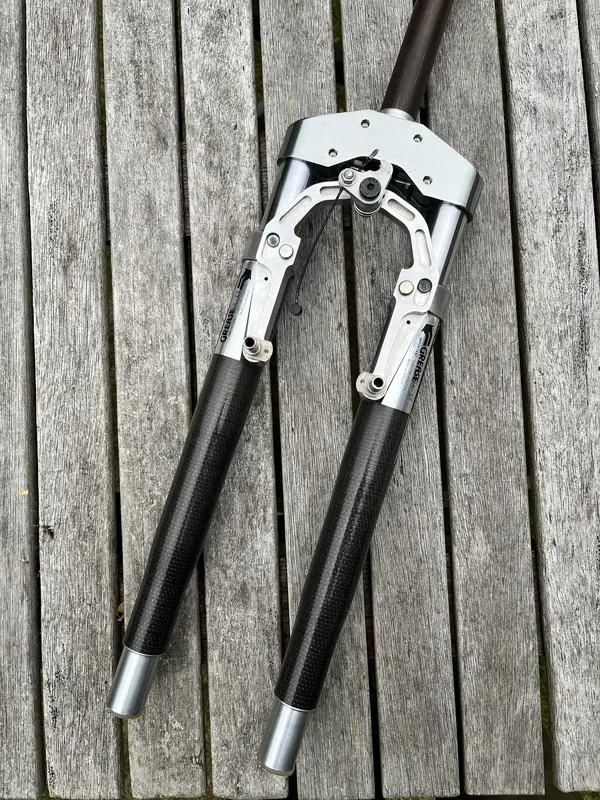You are using an out of date browser. It may not display this or other websites correctly.
You should upgrade or use an alternative browser.
You should upgrade or use an alternative browser.
FORK-English: the final countdown!
- Thread starter justbackdated
- Start date
justbackdated
Retrobike Rider
- Feedback
- View
Hello, yes; still doing services and rebuilds at presentHi justbackdated I've just posted asking for some help and have stumbled upon this thread! Are you still doing fork servicing or have you moved into retirement mode now?
justbackdated
Retrobike Rider
- Feedback
- View
justbackdated
Retrobike Rider
- Feedback
- View
justbackdated
Retrobike Rider
- Feedback
- View
Good question:Tim, how do you restore/preserve over time the shininess of the carbon/kevlar legs?
first of all don’t use any of the chemical cleaning fluids (like Muc-Off) on the carbon as it removes the shine and seems to dry it out, if that is possible.
Clean with a bit of soap & water, car wash/wax is good.
It is possible to restore a bit of colour and lustre to a tired finish by rubbing an oil into the surface of the carbon, I have found Tri-Flow works fantastically but I don’t think it is available now, I am using an ages old spray can of it. It contains Teflon and is a bit thicker than WD40 or GT85 etc.

A car body wax might do well but I have not tried it.
Neither have I tried any applied finishes like spray varnish or clear-coat, and those that I have seen done always seem to be peeling.
Perhaps someone with a bit more knowledge of the structure and make up of carbon can explain why that is.
Hope that helps. Cheers.
It did help, thanks. About carbon structure, maybe @yakboy and @My_Teenage_Self and their fantastic Lotus have this knowledge?
Last edited:
- Feedback
- View
Typically carbon fibre is impervious to most things, except the resins used to bond carbon fibre aren't UV stable and unprotected resin will 'age'; lose it's shine, go yellow, become brittle etc. Therefore, almost all carbon fibre is finished with a UV stable clearcoat (or paint). Tim may be able to help here; I don't think my Pace forks look like they have a separate clear coat on them?
If you notice that the carbon looks a little dull/dry it's probably just the fact you're looking at raw unprotected carbon and UV degraded resin that's 30 years old. Check out the INSIDE of your sliders - the carbon has a different finish entirely as I'm assuming it was prepreg formed over mandrel = super smooth, with no UV exposure. But most CF (bike parts) are NOT formed the way I think the pace legs were - most are formed IN a mould not OVER a mould.
Pace legs = Prepreg carbon wrapped around a tube, then baked and pulled off of the tube. Outside is a little rough, inside is super smooth.
There's a bunch of ways to form carbon, but most involve an external mould leading to a smooth external finish.
A decent car wax will work wonders and would be my #1 choice, but is a short term solution. 2k lacquer is the nuclear option... but here's the rub; it won't adhere that well without abrading the carbon/resin first - it needs a good key...
...And... (sorry) I'll disagree with the venerable Yakboy; I wouldn't touch a set of pace forks with any form of abrasive. I believe you'll be sanding directly into the carbon fibre, ruining the aesthetics. His lotus and spinergies both have/had paint/lacquer to start with and can be sanded all you want. Same as my OCLV. The paint was over 2mm thick in places.
TLDR; Use a decent car wax every 12 months it won't hurt the carbon at all, and will actually protect it (from degradation)
it won't hurt the carbon at all, and will actually protect it (from degradation)
If you notice that the carbon looks a little dull/dry it's probably just the fact you're looking at raw unprotected carbon and UV degraded resin that's 30 years old. Check out the INSIDE of your sliders - the carbon has a different finish entirely as I'm assuming it was prepreg formed over mandrel = super smooth, with no UV exposure. But most CF (bike parts) are NOT formed the way I think the pace legs were - most are formed IN a mould not OVER a mould.
Pace legs = Prepreg carbon wrapped around a tube, then baked and pulled off of the tube. Outside is a little rough, inside is super smooth.
There's a bunch of ways to form carbon, but most involve an external mould leading to a smooth external finish.
A decent car wax will work wonders and would be my #1 choice, but is a short term solution. 2k lacquer is the nuclear option... but here's the rub; it won't adhere that well without abrading the carbon/resin first - it needs a good key...
...And... (sorry) I'll disagree with the venerable Yakboy; I wouldn't touch a set of pace forks with any form of abrasive. I believe you'll be sanding directly into the carbon fibre, ruining the aesthetics. His lotus and spinergies both have/had paint/lacquer to start with and can be sanded all you want. Same as my OCLV. The paint was over 2mm thick in places.
TLDR; Use a decent car wax every 12 months
justbackdated
Retrobike Rider
- Feedback
- View
Thanks for the above replies both; excellent. 
I can remember when using some of the 1998 carbons to build the ‘99 ‘Ltd Edition Pro Class’ that we had to unwrap the individual carbon tubes. They were wrapped in a clear tape (cellophane??) termed a ‘compression tape’ which probably confirms that the carbon was laid down on a mandrel type former. This was stepped to provide a stop for the lower bushing when it was pushed inside the leg. You can sometimes make out the spiral traces of the tape on the outside of the carbon if it is in good nick.
I guess the later PC2 carbons with the ultra smooth surface were formed within a tube but I never got involved with the production of brought-in components, too busy servicing stuff!!
I can remember when using some of the 1998 carbons to build the ‘99 ‘Ltd Edition Pro Class’ that we had to unwrap the individual carbon tubes. They were wrapped in a clear tape (cellophane??) termed a ‘compression tape’ which probably confirms that the carbon was laid down on a mandrel type former. This was stepped to provide a stop for the lower bushing when it was pushed inside the leg. You can sometimes make out the spiral traces of the tape on the outside of the carbon if it is in good nick.
I guess the later PC2 carbons with the ultra smooth surface were formed within a tube but I never got involved with the production of brought-in components, too busy servicing stuff!!
Similar threads
- Replies
- 12
- Views
- 553
- Replies
- 17
- Views
- 1K
- Replies
- 0
- Views
- 563
- Replies
- 4
- Views
- 1K


